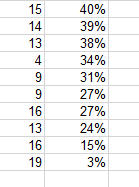12.6 Linear Correlation and Regression
- I think that attendance in class and grades are related.
- Mathematically what I am saying is that they are Correlated
- Notice I did not say missing classes causes lower grades.
- People may not attend class for many reasons.
- I have two pieces of information for each student that I want to look at
- The first is the total number of absences.
- The second is the class score.
- A screen shot of part of the data:
-

-

- Summary statistics
-

- Sometimes it is helpful to draw a Box and Whisker Plot
- In this picture, the Min-Max is displayed
- As well as any outliers or extreme data.
-

-

- In both cases it looks like 19 days missed with 3% is an outlier
- We want to identify an independent and a dependent variable.
- The independent variable is something we have control over.
- The dependent variable is something that depends on the independent variable.
- In this case, we assume the student has control over the number of days absent, so this is the independent variable.
- A scatter plot or scatter diagram gives us an indication of how the data is related
- Plot the independent variable on the x axis
- Plot the dependent variable on the y axis.
-

- Even with the outlier, it looks like there is a relationship
- As days missed goes up, the class average goes down.
- This is an inverse relationship.
- Or a negative correlation
- The question is, could we draw a "line" that approximated the data?
-

- Here are some scatter plots from the book

- But what is this r value?
- $r=\frac{n(\Sigma xy) - (\Sigma x) (\Sigma y)}{\sqrt{n(\Sigma x^2)-(\Sigma x)^2} \sqrt{n(\Sigma y^2) - (\Sigma y)^2}}$
- r is called the correlation coefficient
- You can build this in a table.
- But for any real data set you should use software.
- For our data the value is -.71
- correlation coefficient
- 1 means correlation
- -1 means negative correlation
- 0 means no correlation.
- There are ways to test to see if the correlation is "significant" or what is the likelihood that something identified as a correlation is in error.
- In general it depends on the amount of data and the probability of error.
-

- There are also formulas for computing the line of best fit.
-

- You can ask excel to display this for you.
-

- For data in the range (0 ≤ days missed ≤ 19) you can use this equation to estimate the class grade.










